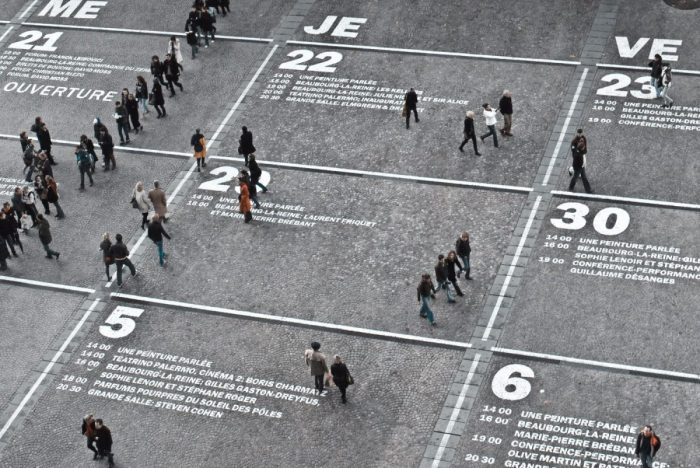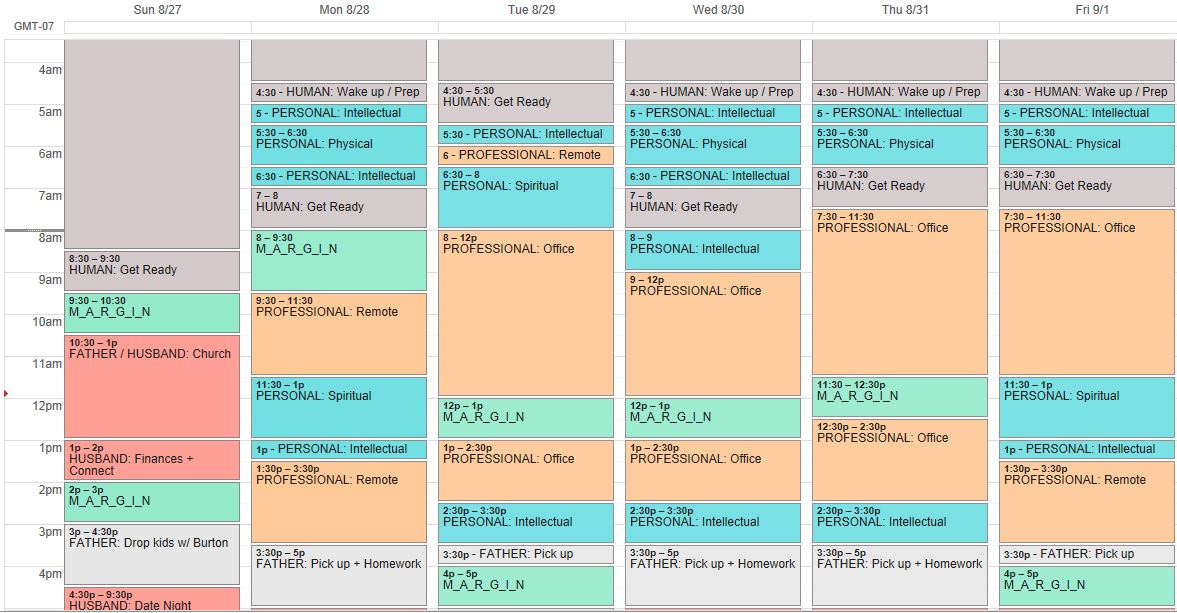By
Austin Collins
It was May 2015. During the previous 3 months, we completed construction and moved into a new home, my wife left her job to start her own company, and we finalized adoption paperwork for our 3 children. In August we would travel to the Philippines to bring the kids home. Panic. I had no idea how I was going to manage my time with all of these changes. The sloppy, reactive time management strategies I’d used in the past required an overhaul. I needed a system. A system that would allow me to step back and work ON my life as well as IN my life.

As a financial advisor, I often recommend my clients use systematic savings from their paycheck to simulate a planned increase to expenses. They “test drive” the elevated future expense load before deciding to commit. Can the same concept be applied to time? Yes. It turns out there is a perfect tool for that job. It’s called the Ideal Week.
What would your Ideal Week look like? How would you spend your time if you had complete control over all 168 hours? A week like this will never happen. Yet the process of designing this Ideal Week offers surprising and compelling benefits.
Here’s why you should design your own Ideal Week:
- Clearly define all Areas of Responsibility (AORs) and determine current level of commitment to each.
- Awareness of conflicts between time demands.
- Real time visual comparison of real calendar vs. ideal calendar.
- Understand how to best paint values and intentions on the canvas of time.
- Use “margin” to minimize overcommitment and stress.
- Identify opportunities to take proactive & productive action.
I used the exact process outlined below to create my Ideal Week. Then I lived on that schedule for the next 3 months. The time management equivalent of simulating higher expenses with systematic savings.
The most significant change was an immediate 15 hour reduction in my workweek. Every weekday, I forced myself to stop working and sit in the sun at 3:30 pm (the same time I would soon be picking our kids up from school).
Instead of stress I felt empowered. Suddenly I was inspired with focused creativity to get more high quality output from fewer hours. This is what happened:
- Began to delegate consistently and effectively.
- Stopped wasting time.
- Eliminated redundant and irrelevant processes.
- Stress was absent because I had plenty of time to figure things out before adding kids into the mix. This translated into less self judgment and greater creativity.
But there are a seemingly infinite number of time management systems and philosophies. How do you find the right one? My approach was to synthesize ideas from thought leaders with proven track records. A list of the sources I used personally is included at the end of this post.
Without further ado, here is the step by step process for creating your own Ideal Week.
Step 1: Gather materials
- Existing calendar (previous 4 weeks): Seeing how your time is currently spent is a helpful reference as you build your Ideal Week. Compare your completed Ideal Week with your actual calendar and brainstorm possible changes in how you allocate time.
- Blank calendar: Use a calendar format that will be easy to reference quickly in real time when you are using your actual calendar. You can quickly check how your actual time commitments compare to your ideal time commitments. My consolidated personal and professional calendars are on Google Calendar. A separate Google Calendar calendar called “Ideal Week” works perfectly. With one click I can toggle the Ideal Week on and view it side by side with my actual week.
- Areas of Responsibility: Make a list of each of the genres of life in which you have responsibility at this moment. Some of these may have sub categories, while others may not. Here is an example from part of my list:
- Human
- Husband
- Father
- Personal (Intellectual, Physical, Spiritual)
- Professional
- “Margin”
- Personal values: A current values list is a helpful reference when evaluating trade offs of how to allocate your time.
Step 2: Prioritize AORs
This is one of the main benefits of the ideal week. Your values list can be of help here. Make a list starting with your most important AOR at the top. Rank the others below in descending order of priority. When you fill your ideal week, you will start at the top of this list and work down. This step can be trickier than it looks. A personal example: In order to be of service to others, I believe I must be centered and present. Therefore, I prioritize “human” and “personal” above all other AORs.
Step 3: Schedule your Ideal Week
Start by blocking out the hours (for the entire week) required for your first priority AOR. Work your way down the list until you either get to the bottom, or run out of space in your week. Color code time blocks by AOR. Then you can visually check your relative level of commitment to each AOR (how much time do you have for work vs. family, etc…). Keep these in mind as you schedule your week:
- Clarity allows you to embrace the trade offs.
- Expect to make a few hard choices.
- Walk the line between ideal & realistic. Your Ideal Week should not neglect important commitments or financial responsibilities.
As a reference, here is a snapshot of my current Ideal Week:

Step 4: Set a “change buffer” for your real world calendar.
The world wants to control your time. Meetings pop up or change with little notice. Carpools and social commitments are always shifting. A “change buffer” creates the space necessary to align your actual calendar with your Ideal Week.
In general, the earliest a commitment is added to my calendar is one week in the future. This applies whether the engagement is new or being rescheduled. I call this a “calendar buffer.” Naturally, I’m always free to make necessary short notice changes. But implementing this buffer for externally driven change allows me to allocate my time with greater perspective.
Step 5: Optimize
You have completed your Ideal Week! This tool is most valuable when used and optimized consistently. I use a running list in Evernote to keep track of what’s working well, and any opportunities to improve.
These questions have been useful in the ongoing optimizing process:
What is the best time of day for each block of time? All hours do NOT have equal value. I used to sleep from 11 pm to 6 am. Now I sleep from 9:30 pm to 4:30 am. Same 7 hours of sleep, but I traded 1.5 hours of evening time for 1.5 hours of morning time. Morning time is more productive, especially with the force multiplier of intense early morning exercise. I hate waking up early, but the benefits are too great to ignore. Give this a shot. Discipline equals freedom.
In which AORs do I feel off balance for more than a few days in a row? Most single days feel off balance in one way or another. Expect that. That feeling should fade over several days. If not, the Ideal Week should be adjusted to more accurately reflect the ideal execution of current priorities.
How is my “calendar buffer” working? It is critical to identify the different external forces that shape your time. Start a running list of all the external events that cause your calendar to change. Each time you change your calendar, write down the cause (kids, spouse, clients, etc…). Once you understand the source of the changes, you can craft a strategy to manage the changes from each source.
Ideal Week Resources
The concept of both Ideal Week and “margin” came from this podcast by Michael Hyatt. I loved the concepts, but needed a toolkit to adapt them to my life. So I read (or re-read) the following relevant books:
I have iterated my Ideal Week several times over the last couple years. These are distilled bullets from my “Aha!” moments which fueled these iterations.
- Brainstorm. Be creative. Ask “what if…?”
- Give yourself permission to try things for a week without judgment.
- Look for patterns. Build on positive ones, replace negative ones.
- Where can you spend time simultaneously on multiple AORs? Here are a few of my favorites:
- Do push ups while watching TV.
- Get a customized education while commuting (podcasts and audiobooks).
- Learn to think and communicate more concisely by becoming a better writer.
- Where can you save time? What time is spent needlessly?
- Apply the 80/20 law whenever possible.
- What are the 20% of the things in your schedule (look backwards) that give you 80% of your enjoyment? Make sure they are in your ideal week.
- What are the 20% of the things that give you 80% of your frustration? How can you negotiate, reduce or eliminate those?
Remember: It’s easy to live reactively when your priorities are not clear. It’s easy to feel like a victim when you don’t believe you have any agency.



